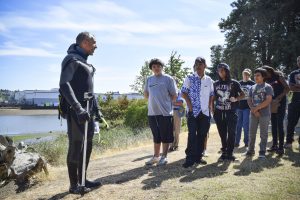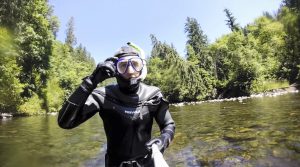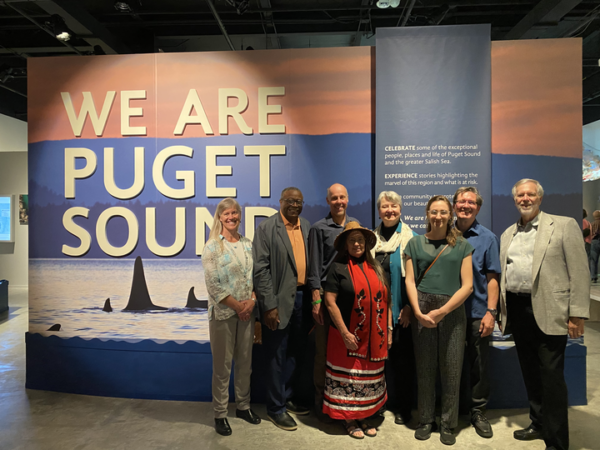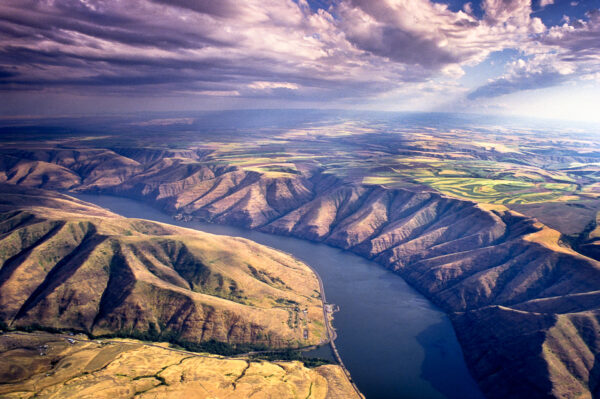 To highlight this connection between rivers and Puget Sound, WEC launched our Swim Duwamish project at the beginning of the summer. For the past few months, I’ve been swimming the Duwamish River from its source in the Green River all the way to Puget Sound, using a GoPro camera to take underwater video along the way. To help share the experience with more people, we’ve been creating short videos and blogposts documenting this 85-mile journey, all online at SwimDuwamish.org.
To highlight this connection between rivers and Puget Sound, WEC launched our Swim Duwamish project at the beginning of the summer. For the past few months, I’ve been swimming the Duwamish River from its source in the Green River all the way to Puget Sound, using a GoPro camera to take underwater video along the way. To help share the experience with more people, we’ve been creating short videos and blogposts documenting this 85-mile journey, all online at SwimDuwamish.org.
Why focus on the Duwamish when other rivers are cleaner and have more salmon? Because the Duwamish is an important part of the region’s culture, history, and economy, and is part of daily life for many local residents and businesses. It’s also one of the most polluted sites in the Puget Sound region, and neglecting the Duwamish could hold back the recovery of Puget Sound. And, perhaps most importantly, the Duwamish River is still alive, as shown by the strong return of 600,000 wild pink salmon expected this fall. I captured some amazing footage as they swam past me in the Green River, near Kent.
The Superfund cleanup and public health advisories tend to dominate the news about the Duwamish River. But the surprise of seeing the abundant pink salmon and the river’s pristine headwaters provide hope that we can save the Duwamish. The Superfund cleanup led by the U.S. Environmental Protection Agency has already removed substantial amounts of polluted sediments, with more cleanup to come. Duwamish advocates, led by the Duwamish River Cleanup Coalition, continue to advocate for additional cleanup that will make the river’s fish safe to eat. King County and the city of Seattle are leading a planning process that will guide future restoration efforts in the larger Green/Duwamish watershed.
 One of my big takeaways from Swim Duwamish has been the need for stronger connections between people and our waters. It’s been difficult for me to get in and out of the river because of the small number of public access points. And there are relatively few places where people can swim or fish. Strengthening the connections between people and our waters will help build support for saving our rivers and Puget Sound.
One of my big takeaways from Swim Duwamish has been the need for stronger connections between people and our waters. It’s been difficult for me to get in and out of the river because of the small number of public access points. And there are relatively few places where people can swim or fish. Strengthening the connections between people and our waters will help build support for saving our rivers and Puget Sound.
Connections between freshwater and Puget Sound are understood by those doing restoration work, but we need broader understanding that what happens upstream flows downstream. Many of the people I have met on this journey know about their local areas, but are unaware of what’s happening elsewhere. We need to draw the connections between people working to protect different parts of our waters – so that together we can support efforts to save, restore, and clean up the Sound as a whole.
We may see the future of Puget Sound in the Green and Duwamish Rivers. Seattle is both one of the greenest and fastest-growing cities in the U.S. Which of these trends will determine our future? As the rest of the Puget Sound region urbanizes, will we grow in harmony with nature, or will we repeat the mistakes of the past that have led us to a Duwamish in need of help? We hope Swim Duwamish will bring out these lessons and help catalyze action to protect and restore Puget Sound, from the saltwater all the way upstream to the Cascade and Olympic mountains.
A big thank you to our Swim Duwamish partners King County and WRIA 9 (the Green-Duwamish watershed restoration organization) and our sponsors REI and Boeing. To see photos, watch videos, and learn more, visit SwimDuwamish.org
Swim Duwamish from Washington Environmental Council on Vimeo.



